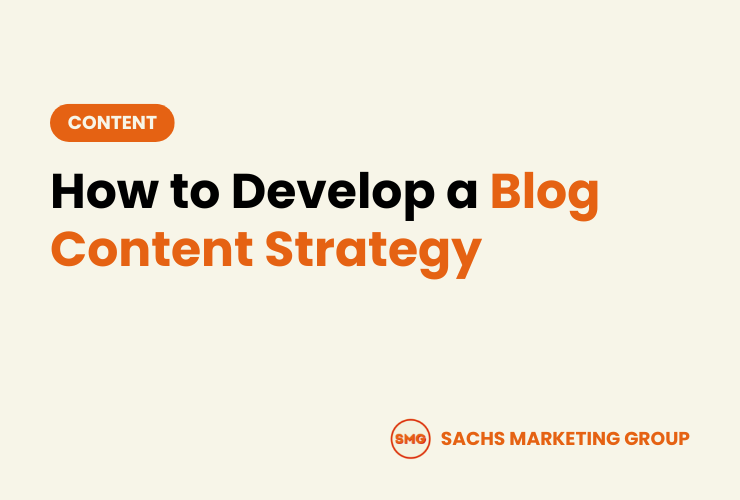Developing a blog content strategy involves defining your goals, researching competitors, creating audience personas, and mapping out blog categories. Further, you’ll need to undertake topical and keyword research, brainstorm content ideas, outline a content calendar, and then publish and market your content. This strategic approach ensures your blog aligns with your business objectives and resonates with your target audience.
If you feel overwhelmed by the chaotic nature of maintaining a blog, it’s time to breathe a sigh of relief.
A well-crafted blog content strategy not only offers a structured approach but also ensures your efforts align with your business goals. The confusion of what to publish next disappears, replaced by a clear roadmap for your content creation.
Above all, it enables your content to truly resonate with your target audience, driving engagement and conversions. In this article, we’re exploring a few steps to help you understand how to develop a blog content strategy for your business.
Overview
How to Develop a Blog Content Strategy
A blog content strategy serves as a blueprint that guides your blogging efforts, helping you publish content that engages your audience and supports your business goals.
Here’s how to develop a blog content strategy …
Define Your Goals
Before you start brainstorming blog topics or creating content, defining your goals is crucial. Clear goals guide your content creation process and provide a benchmark to measure your blog’s success. Consider the following:
What do you hope to achieve with your blog?
- Build brand awareness
- Generate leads
- Establish yourself as a thought leader in your industry
For example, if you run a fitness blog, your goals could be:
Primary Goal:
- Establish yourself as an authoritative figure in the fitness industry
Secondary Goals:
- Increase website traffic by 25% in the next six months
- Increase the number of email subscribers by 20% in the next quarter
- Boost engagement on blog posts by 15% within two months
Research the Competition
Next, take time to research your competition. This step can provide valuable insights for shaping your strategy. Focus on the following:
Identify top blogs in your industry
- Study their most popular posts
- Analyze their post-frequency
- Examine the categories they cover
- Evaluate their engagement levels
- Investigate the keywords they are ranking for
For instance, if your blog is in the tech industry, analyze a competitor like TechCrunch:
Focus Areas:
- Popular posts
- Post frequency
- Categories covered
- Engagement levels
- Keywords ranking
Create Audience Personas
Understanding your audience is crucial for creating a successful blog content strategy. Develop audience personas that detail your ideal readers’ demographics, interests, challenges, and online behaviors:
- Demographics
- Interests
- Challenges
- Online behaviors
For a travel blog targeting travel enthusiasts:
Example Persona: “Adventure Adam”
- 28 years old
- Loves hiking and exploring off-beat travel destinations
- Searches for eco-friendly travel tips
- Appreciates detailed itineraries and high-quality images
Map Out Your Blog Categories
Your blog should have defined categories that align with your business objectives, audience interests, and keyword research. It’s tempting to create a new category for every new topic, but this can result in a messy collection of categories that lack focus. For the best results, keep your categories lean and use tags for more specific content organization. Here’s what effective category usage achieves:
- Organizes your blog content
- Guides content creation process
- Improves user experience
For a home services blog, potential categories might include:
- Home Maintenance: Seasonal Checklists, Repairs, DIY Tips
- Landscaping: Garden Design, Lawn Care, Outdoor Projects
- Cleaning Services: House Cleaning, Carpet Cleaning, Deep Cleaning
- Renovations: Kitchen Remodels, Bathroom Upgrades, Room Additions
- Energy Efficiency: Insulation, Solar Panels, Energy-Saving Tips
By organizing your content into clear, focused categories, you make it easier for readers to find the information they need and for you to maintain a cohesive blog structure.
Related: The Professional’s Guide to Home Services Marketing
Begin Your Topical and Keyword Research
Starting your topical and keyword research is critical in ensuring your blog content aligns with what your audience is searching for. Skipping this step is a common mistake. Creating content without knowing what your audience is searching for is like taking a shot in the dark and usually results in a miss.
Here’s how to approach it:
- Use SEO Tools like Google Keyword Planner
- Identify High-Volume Keywords based on search volume and keyword difficulty.
- Analyze Competitor Content to see what topics are engaging their audience.
- Focus on Long-Tail Keywords that are specific and have lower competition.
- Monitor Trends using tools like Google Trends and Exploding Topics to stay updated with industry news.
- Categorize Your Findings to align with your blog’s main topics and audience interests.
- Create a Keyword List to guide your content creation and optimization.
Check out our guide to get started! How to Select Keywords (3 Simple Steps)
For example, if you’re a roofing company, researching “roofing materials” might reveal popular keywords like “best commercial roofing materials” and “lifespan of roofing materials,” guiding your content creation strategy effectively.
Related: Digital Marketing for Roofing Contractors
Brainstorm Content Ideas
Now, it’s time to brainstorm content ideas. Use your keyword and topical research to generate relevant blog posts. Consider different types of content and keep your audience personas in mind to ensure relevance.
Review Keyword Research:
- Focus on high-volume, relevant keywords.
Content Types:
- How-to guides
- Listicles
- Opinion pieces
- Interviews
Audience Personas:
- Tailor topics to your readers’ interests and needs.
Analyze Competitors:
- Identify popular topics and gaps.
Monitor Trends:
- Stay updated with industry news.
Incorporate Seasonal Themes:
- Plan around holidays and events.
For example, if you publish a blog about mental health, you might brainstorm topics such as:
- “How to Talk About Mental Health with Loved Ones” (How-to guide)
- “The 10 Most Common Mental Health Conditions” (Listicle)
- “Why Self-Care is Essential for Mental Well-being” (Opinion)
- “Interview with a Mental Health Professional: Tips and Advice” (Interview)
Related: Digital Marketing for Mental Health Professionals
Create Your Content Calendar
Once you have a list of content ideas, organizing them with a content calendar is crucial. This tool helps you plan what to publish, when, and where. A content calendar ensures consistency and allows for strategic planning around events and holidays.
For example, a beauty blog might plan to publish articles twice a week:
- Publication Days: Wednesdays and Saturdays
- Monthly Topics: Skincare in winter, Valentine’s Day makeup tutorials, Best beauty products for dry skin
- Deadlines: Draft submissions, Final edits, Publishing dates
Using a content calendar, you can maintain a steady posting schedule and capitalize on seasonal trends and special events.
Write Your Content!
Creating engaging content is the crux of your blog strategy. This is where your research and planning come to fruition, crafting posts that resonate with your audience and optimize for SEO. Ensure your content is valuable, original, and well-structured, with a clear call to action to drive engagement.
Key points to remember:
- Value: Provide valuable and relevant information.
- Originality: Ensure content is unique and fresh.
- Structure: Organize content with clear headings and sections.
- SEO Optimization: Use chosen keywords effectively.
- Engagement: Include a clear call to action (CTA).
By following these principles, your content will attract and retain readers, enhancing your blog’s effectiveness.
Hit Publish and Track Your Metrics
Once your content is live, your job isn’t done. The next crucial step is to monitor your blog performance. Tracking the most important content marketing metrics like views, unique visitors, and conversions can provide valuable insights into how your content is performing.
This data helps you understand your audience’s behavior better, what they appreciate, what they don’t, and what actions they take after consuming your content. It’s through this analysis that you can refine your blog content strategy, focusing on what works and improving or discarding what doesn’t.
Here at Sachs Marketing Group, our SEO team tracks the most important metrics in order to refine the blog content strategy moving forward. This helps ensure we’re using data-driven insight to ensure content reaches more potential customers and has a positive impact on our clients’ businesses.
FAQs
As we delve deeper into blog content strategies, it’s natural to have a few queries. Here, we aim to answer some of the most frequently asked questions:
What is a blogging strategy?
A blogging strategy is a planned approach to creating and promoting content on a blog. It involves determining the purpose of your blog, understanding your audience, researching and using relevant keywords, creating quality content, and promoting it to maximize visibility and reach.
How do I create a content strategy for my blog?
Creating a content strategy for your blog involves several steps: defining your blog’s goals, understanding your target audience, researching competitors and keywords, brainstorming content ideas, and creating a content calendar. Furthermore, creating quality content and promoting it effectively are also critical parts of your strategy.
How do you create content for a blog?
Creating content for a blog involves identifying topics that interest your audience, researching relevant keywords, creating an outline, writing the post, adding visual elements, and optimizing the post for SEO. After publishing, the blog post should be promoted on relevant platforms to maximize its reach.
What makes good blog content?
Good blog content is original, valuable, and engaging. It addresses the interests or problems of the target audience, is well-structured and easy to read, uses compelling visuals, and is optimized for search engines. It also includes a clear call to action, guiding readers on what to do next.
Need Help with Your Blog Content Strategy?
Are you ready to revolutionize your blog with an effective content strategy but feel overwhelmed? Sachs Marketing Group is here to help!
With a thorough understanding of your goals and audience, our digital marketing agency can craft a custom blog content strategy that aligns with your business objectives and resonates with your readers. Not only will we help streamline your blogging efforts, but we will also ensure that your content effectively attracts, engages, and converts your target audience.
Contact us today to learn more about our services!
Conclusion
Now that you know how to develop a blog content strategy, it’s time to get started!
Creating a blog content strategy might seem like a daunting task, but the benefits it brings to your blogging efforts are substantial. By having a clear understanding of your goals, audience, and the competitive landscape, you can craft compelling content that truly resonates with your readers.
Remember, consistency is key – stick to your content calendar, keep your audience engaged, and don’t shy away from revising your strategy based on your blog’s performance.
With a solid blog content strategy, your blog can become an effective tool in your marketing arsenal, driving traffic, building brand awareness, and generating leads.
2 Comments
Leave a Reply
Contact us today to get the conversation started!













This post was helpful for my blog content strategy, but it could be improved with some bullet points. However, the post was still easy to read. Thank you for sharing.
Thanks for reading! We’ve updated this post with bullet points based on your helpful feedback.